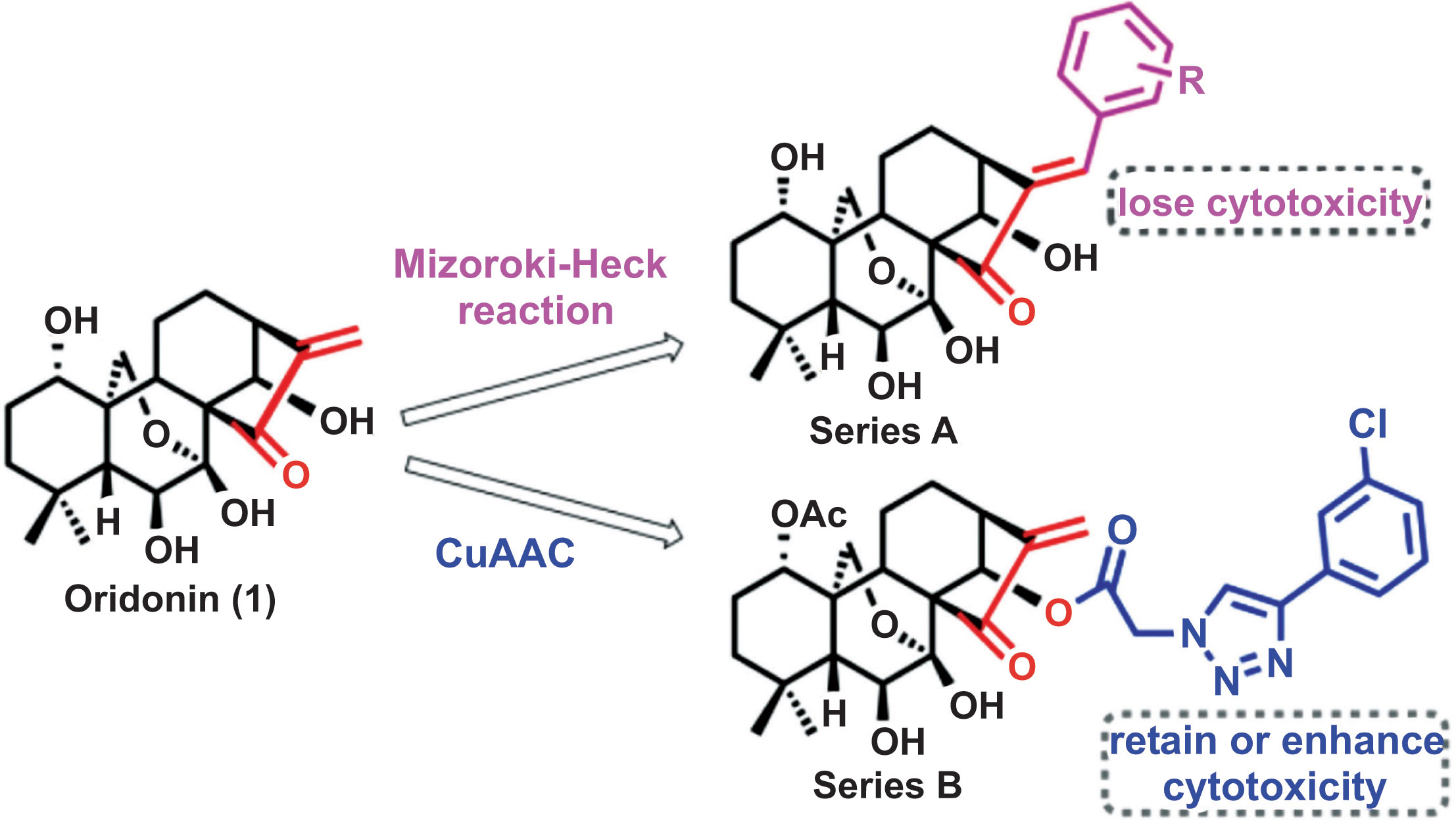Article Details
Synthesis of Oridonin Derivatives via Mizoroki-Heck Reaction and Click Chemistry for Cytotoxic Activity
Author(s):
Wei Hou, Qiuju Fan, Lin Su* and Hongtao Xu* Pages 935 - 947 ( 13 )
Abstract:
<P>Background: Natural products (NPs) are evolutionarily chosen “privileged structures” that have a profound impact upon the anticancer drug discovery and development progress. However, the search for new drugs based on structure modification of NPs has often been hindered due to the tedious and complicated synthetic pathways. Fortunately, Mizoroki-Heck reaction and copper-catalyzed alkyne-azide cycloaddition (CuAAC) could provide perfect strategies for selective modification on NPs even in the presence of liable functionalities. </P><P> Objective: Here, we used oridonin, an ent-kaurane diterpenoid that showed a wide range of biological activities, as a parent molecule for the generation of analogues with anticancer activity. </P><P> Methods: Derivatives of oridonin were generated based on the structure-activity relationship study of oridonin and synthesized via Mizoroki-Heck reaction and CuAAC. The cytotoxicity of new oridonin derivatives were evaluated on both cancer cells and normal cells. Furthermore, the apoptotic effect and cell cycle arrest effect of the selected potent analogue were evaluated by flow cytometry and western blotting analysis. </P><P> Results: Two series of novel C-14 and C-17 modified derivatives of oridonin were obtained via Heck reaction and copper-catalyzed alkyne-azide cycloaddition (CuAAC), respectively. In vitro antiproliferative activities showed that the introduction of C-14 (2-triazole)acetoxyl- moiety could retain or enhance cytotoxicity, whereas the introduction of C-17 phenyl ring might exert negative effect. Further studies demonstrated that derivative 23 exhibited broad-spectrum antiproliferative activity, effectively overcame drug-resistance and showed weak cytotoxicity on non-cancer cells. Preliminary mechanistic studies indicated that 23 might cause G2/M phase arrest and induce apoptosis in PC-3 cells. </P><P> Conclusion: Mizoroki-Heck reaction and CuAAC are perfect strategies for structure modification of complex natural products. The introduction of C-14 (2-triazole)acetoxyl- moiety could retain or enhance the cytotoxicity of oridonin, the introduction of C-17 phenyl group might exert negative effect on its cytotoxicity.</P>
Keywords:
Natural products, oridonin, Mizoroki-Heck reaction, click chemistry, CuAAC, G2/M, apoptosis, cytotoxicity.
Affiliation:
College of Pharmaceutical Science, and Institute of Drug Development & Chemical Biology (IDD&CB), Zhejiang University of Technology, Hangzhou, 310014, Shanghai Jiaotong University School of Medicine, Shanghai, 200025, College of Pharmaceutical Science, and Institute of Drug Development & Chemical Biology (IDD&CB), Zhejiang University of Technology, Hangzhou, 310014, Shanghai Institute for Advanced Immunochemical Studies (SIAIS), Shanghai Tech University, Shanghai, 201210
Graphical Abstract:

Read Full-Text article